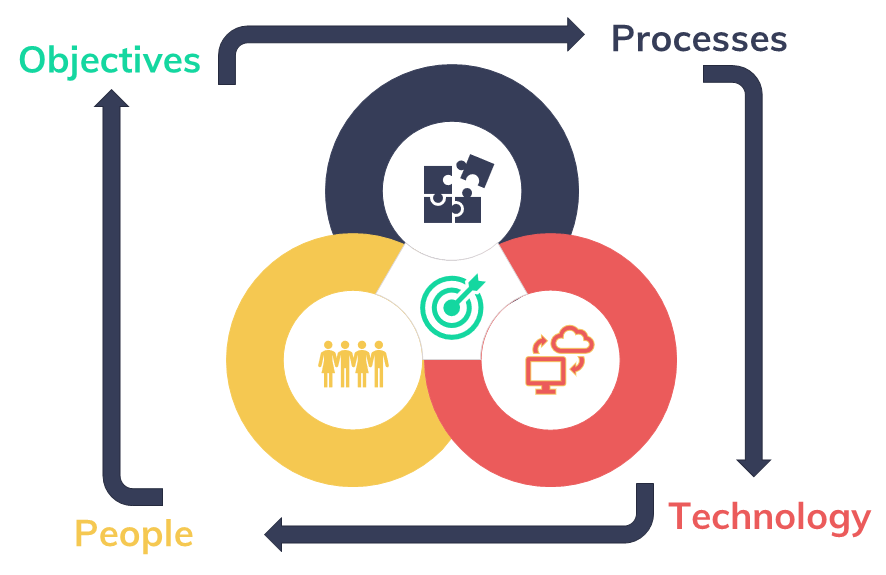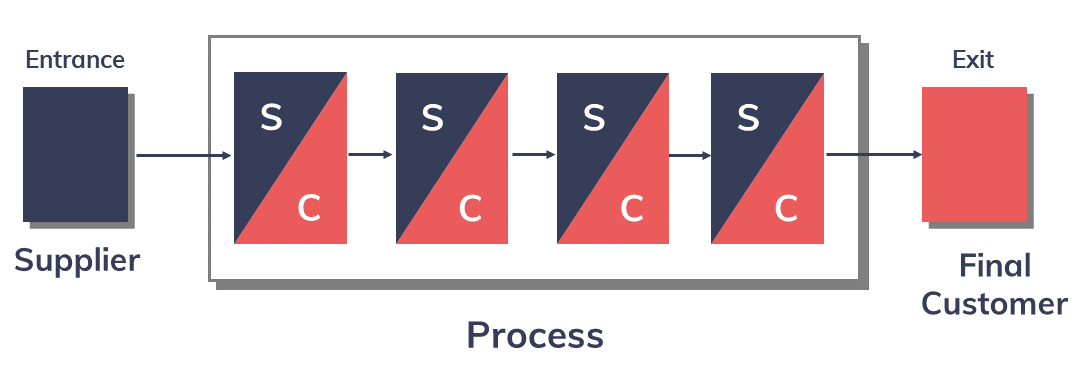The strategy to processes through projects
Every company has its strategy more or less defined. Companies know in which situation they would like to be in the long term, although it is currently unusual for organizations to have an approach beyond 3 years, an issue that is worsening with the current instability crisis.
This strategy consists of modifying the status quo from the known present situation, in such a way that it is possible to achieve the established objectives and ensure the survival of the organization.
This status quo refers to how the organisation is running its processes, what business rules it is operating under, how it is leveraging the technology it has to support those processes and, finally, what policies it uses with people to get the most out of all of the above.
The organisation that has the most efficient processes, has the right rules in place to meet the changing demands of its customers, leverages existing technology in innovative and disruptive ways, and has the policies to maximise the value that its human capital brings, will win. It is as simple as that. But it's not that simple at all.

Having the most efficient processes implies, on the one hand, that the value added by each activity is high for a certain investment in resources and, on the other hand, that you are able to keep it under control, i.e. that there are certain KPIs that are being monitored to detect possible decreases in performance.
Maximising the value of any process, Lean techniques are used to reduce or eliminate waste, or muda as it is known in its terminology. It should be borne in mind that, on average, the percentage of added value of a standard process can be around 25-35% compared to what does not add value, because it is not only what is done, but how it is done. The activity itself may add value, but the way it is done may be inefficient due to unnecessary waiting or travel, as well.
At Izertis we use techniques such as Value Stream Mapping, Waterfall Analysis or Value Add Analysis to extract the maximum value from a process and eliminate waste. These are tools designed to make this waste of time and resources visible, and once identified, design action plans to mitigate it as far as possible and thus improve the process.
But at Izertis our approach to this type of issue is not through extensive protocols or rigid methodologies, but rather we advocate the creation of task forces to carry out Kaizen Events to attack this specific problem and obtain results in just a few weeks. The key is the participation of all the teams involved and affected by this process in order to obtain the best overall commitment for those involved.
On the other hand, it is necessary to have the tools to be able to monitor the performance of the processes since something inherent to these, being iterative, is their variability in each execution cycle. It is important to know how to interpret this variability, as it is necessary to distinguish between variability due to common causes, known as Voice of the Process, which is expected, predictable and inevitable, and variability due to special causes, which is necessary to understand and develop action plans to bring the process back under control.
Common mistakes in this regard include the selection of an excessive number of metrics that make it difficult to interpret what is happening in the process. Another mistake is not making the scorecard visible. The more visibility it has for the people who operate it, the better, and this can even lead to a gamification strategy in which they compete cooperatively to obtain the best result.
In order to have the most appropriate rules, it is necessary for the organisation to listen to the customer, becoming a true Customer Centric organisation. But in Processes, the final or external customer is not the only one and at Izertis we know this very well. All processes organise their sequence of activities according to a supplier/customer pattern, therefore, there are also internal customers who must be listened to and paid attention to.

Through tools such as Voice of the Customer or KANO questionnaires, we can find out exactly what is important to customers, both internal and external, and modify processes to meet their expectations. There is no doubt that technology can be a great ally for the success of an organisation. But technology is not an end in itself, but the platform on which processes are supported. And to the extent that it helps to execute efficient processes and to better meet the needs of customers (both external and internal), it will become a competitive advantage that could lead to an exponential improvement in the company's results.
For this reason, technology surveillance is an area to which we always pay attention and resources at Izertis, which leads us to be able to identify innovative uses applicable to our clients. This is when we can talk about process re-engineering where many paradigms or dogmas of the organisation can be questioned and where the organisation itself can suffer. Because the most important aspect of a process reengineering, without any doubt, is the impact it will have on people.
The success of this transformation will be determined by the degree of people's acceptance of the new status quo. There is a simple formula that defines the effectiveness of an implemented solution:
Effectiveness = Quality of the Solution x Acceptance
This means that no matter how good this solution is, if it is not accepted by the organisation, its effectiveness will be very limited. That is why at Izertis we are very aware of the importance of managing change from a people-centred approach, considering their concerns, their doubts and even their fears, so that both the adoption time and the initial decrease in performance intrinsic to any change are as short as possible. And we achieve this with strategic change management, as opposed to the more usual tactical change management when it comes to implementing change.
Finally, this metamorphosis of the organisation, in terms of processes, business rules, technology and people, will be the result of the projects. The success and sustainability of the changes sought will depend on their correct management, since any project that fails to implement a change, even if it has been carried out correctly in terms of time, cost and scope, will be a failure in reality.

